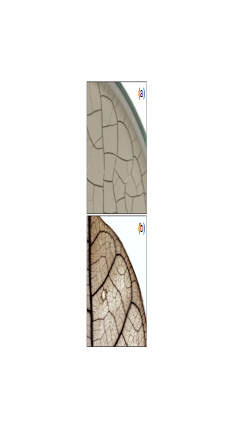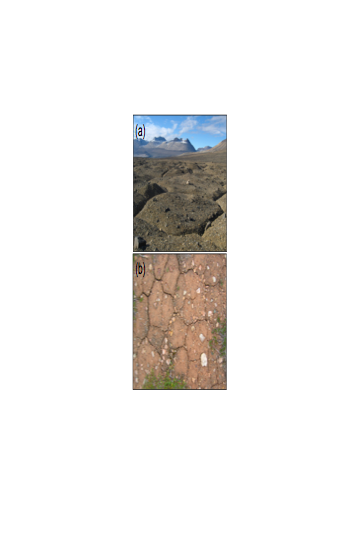Dynamics of crack patterns

In nature, ordered crack patterns are found in situations ranging from cracks in garden mud, to the snouts of Nile crocodiles or the vast polygonal networks that stretch across the polar deserts of Earth and Mars. To a degree these patterns can also be controlled, as in the artistic craquelure of paintings and pottery. More precise control can be made by the imprinting of memory in vibrated pastes or the lithographic templating of nanoscopic crack patterns, for example. The physics of these patterns is captured by an energy balance as the cracks grow. Unlike many other physical problems, however, crack growth involves only a local energy minimisation, at the point and time that a crack is growing, rather than the global minimisation of some functional. Since energy can be released by the widening of a crack anywhere along its path, whereas to a good approximation energy is only spent in a small region immediately around a growing crack tip, the entire history of the crack affects how it will grow at any instant. This means that although the highly practical question of whether a crack will grow or not (and hence, whether a bridge will fall down, or an airplane wing snap off) is solved, one cannot accurately predict the direction that a crack will grow in any but the simplest cases. We are investigating the dynamics of cracks in thin sheets, with two general long-term goals:
-
•Predicting how a crack will grow in an arbitrary situation, and
-
•Designing/templating structures to give a desired crack pattern.

Figure 1: (a) The crack pattern of dried clay resembles (b) the venation pattern of a leaf. Both cases grow sequentially (i.e. one crack or vein after another), dividing space into smaller and smaller pieces. The effects of boundary conditions, such as the sidewalls, or previous cracks/veins, affect growth in a similar way.
To this end, we study a number of simple model systems, many inspired directly by nature. These involve cracks in curved surfaces, cracks over patterned substrates, wavy cracks in colloidal films, and crack patterns that evolve through cycles of cracking and healing.
The growth of leaf veins closely resembles how crack patterns form in drying films (see Fig. 1). This apparent similarity leads to many questions regarding fracture induced pattern formation. Is this similarity just superficial, or it is due to homologous morphogenetic mechanisms? We are developing an experimental program to look at fracture and other mechanical instabilities in thin curved films, which resemble the conditions under which leaves develop, that will hope to provide quantitative answers to these questions, and determine if leaf veins are indeed mechanically the same as cracks.
Cracks in thin layers can also be affected by what lies beneath their surface, as sketched in Fig. 2. This applies to cracks that cluster around a buried crater, or cracks in Renaissance paintings that reflect the grain of the wood over which they were painted (see page header), or cracks in films spin-coated over microscopic patterns etched into silicon. The pattern of surface cracks should not depend on the absolute size of the features, as fracture mechanics has no inherent length scales. Rather, as we are finding, the patterns only depends on the relative wavelength and amplitude of the substrate features, and fall into a small number of broad classes.
Wavy cracks (Fig. 3) in colloidal films is one system in which we have made progress predicting how cracks grow. Here, cracks advance directionally, across the film. A wavy crack can appear between two existing straight cracks. The flanking cracks preferentially release stress normal to their surface, and so the wavy crack would gain energy by curving towards either one. However, as it approaches one, it must advance into a region with a lower total strain energy density. A balance between these effects predicts a path that continuously curves towards the local direction of maximum strain energy release rate, which accurately describes the shape of the wavy crack, and its scaling.

Figure 2: Cracks in thin layers can be affected by the shape of their substrate. For a sinuous substrate, as the dimensionless layer thickness decreases, the crack pattern first aligns with the underlying features, then develops secondary instabilities. Although these images show dry mud cracks, ~ 10 cm across, the results should scale to both planetary-scale features, and microscopic cracks.

Figure 3: (a) Wavy cracks in drying colloidal latex films form when a secondary crack tries to advance between two pre-existing straight cracks. (b) A crack path prediction that requires cracks to curve towards the direction of maximum strain energy release rate accurately predicts the relationship between wavelength lambda, film thickness h, and the distance between the bounding cracks, 2b.
References
L. Goehring, S. Tarafdar, T. Dutta, S. Kitsunezaki, and A. Nakahara. Desiccation Cracks and their Patterns. Formation and Modeling in Science and Nature. Wiley, 2015.
P. Nandakishore and L. Goehring, Crack patterns over uneven substrates. Soft Matter (2016, in press).
L. Goehring and S. W. Morris. Cracking mud, freezing dirt, and sculpting rocks. Physics Today, 67 (11), 39-44 (2014).
L. Goehring. Evolving fracture patterns: columnar joints, mud cracks and polygonal terrain. Philosophical Transactions of the Royal Society A, 371, 20120353 (2013).
L. Goehring, W. J. Clegg, and A. F. Routh. Wavy cracks in drying colloidal films. Soft Matter, 7, 7984-7987 (2011).
L. Goehring, R. Conroy, and A. Akhter, W. J. Clegg, and A. F. Routh. Evolution of mud-crack patterns during repeated drying cycles. Soft Matter, 6, 3562 (2010).

Finally, we have learned how cracks can evolve when they are allowed to break and heal, over and over. These experiments are inspired by polygonal terrain, extensive landscapes of crack patterns that cover the permafrost regions of Earth and Mars, as in Fig. 4. We know these landscapes are evolving, but the dynamics are too slow to see directly. We have studied crack patterns in mud that is repeatedly dried and rewetted, and can explain the resulting patterns (and by extension, the permafrost) by a few simple general assumptions of crack behaviour.
Figure 4: Polygonal terrain (a) is common in permafrost soils. The pattern is dynamic, but the timescales of resurfacing are millennia, at least. Similar dynamics can be studied in clay layers, when they are repeatedly dried and rewetted. The crack pattern evolves from one dominated by rectangular pieces, to one with hexagonal tiles (now, over only weeks). This behaviour can be predicted by assuming that cracks appear near the positions of old cracks, but that the order of cracking is different in each cycle.